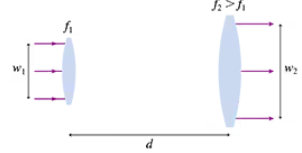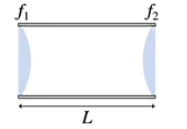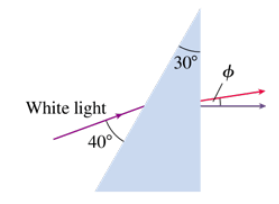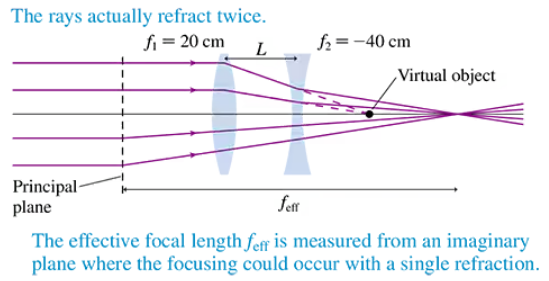 Back
BackProblem 4a
What is the power of a lens with a focal length of 25 mm?
Problem 4b
What is the focal length of a second lens that could be placed in contact with the first lens to provide an overall power of 30 D?
Problem 6
A camera’s close-up lens is aimed at a butterfly 200 mm in front of the lens, creating a focused on the detector 50 mm behind the lens. A proper exposure requires an f-number of F8.0. What is the correct diameter of the lens aperture?
Problem 9
A camera takes a properly exposed photo at F5.6 and 1/125 s. What shutter speed should be used if the lens is changed to F4.0?
Problem 12a
Ramon has contact lenses with the prescription +2.0 D. What eye condition does Ramon have?
Problem 13
What is the f-number of a relaxed eye with the pupil fully dilated to 8.0 mm? Model the eye as a single lens 2.4 cm in front of the retina.
Problem 14
A magnifier has a magnification of 5x. How far from the lens should an object be held so that its is seen at the near-point distance of 25 cm? Assume that your eye is immediately behind the lens.
Problem 16
A microscope has a 160 mm tube length. What focal-length objective will give total magnification ≈ 500x when used with an eyepiece having a focal length of 5.0 cm?
Problem 19
A 20x telescope has a 12-cm-diameter objective lens. What minimum diameter must the eyepiece lens have to collect all the light rays from an on-axis distant source?
Problem 21
A sheet of glass has nred = 1.52 and nviolet = 1.55. A narrow beam of white light is incident on the glass at 30°. What is the angular spread of the light inside the glass?
Problem 22b
A hydrogen discharge lamp emits light with two prominent wavelengths: 656 nm (red) and 486 nm (blue). The light enters a flint-glass prism perpendicular to one face and then refracts through the hypotenuse back into the air. The angle between these two faces is 35°. What is the angle (in degrees) between the red and blue light as it leaves the prism?
Problem 23
Infrared telescopes, which use special infrared detectors, are able to peer farther into star-forming regions of the galaxy because infrared light is not scattered as strongly as is visible light by the tenuous clouds of hydrogen gas from which new stars are created. For what wavelength of light is the scattering only 1% that of light with a visible wavelength of 500 nm?
Problem 24b
A scientist needs to focus a helium-neon laser beam (⋋ = 633 nm) to a 10-μm-diameter spot 8.0 cm behind a lens. What minimum diameter must the lens have?
Problem 28b
A common optical instrument in a laser laboratory is a beam expander. One type of beam expander is shown in FIGURE P35.28. The parallel rays of a laser beam of width w₁ enter from the left. What is the width w2 of the exiting laser beam?
Problem 31
A 1.0-cm-tall object is 110 cm from a screen. A diverging lens with focal length -20 cm is 20 cm in front of the object. What are the focal length and distance from the screen of a second lens that will produce a well-focused, 2.0-cm-tall on the screen?
Problem 32b
A 15-cm-focal-length converging lens is 20 cm to the right of a 7.0-cm-focal-length converging lens. A 1.0-cm-tall object is distance L to the left of the 7.0-cm-focal-length lens. What are the height and orientation of the final image?
Problem 34
The cornea, a boundary between the air and the aqueous humor, has a 3.0 cm focal length when acting alone. What is its radius of curvature?
Problem 35
Mars (6800 km diameter) is viewed through a telescope on a night when it is 1.1 x 10⁸ km from the earth. Its angular size as seen through the eyepiece is 0.50°, the same size as the full moon seen by the naked eye. If the eyepiece focal length is 25 mm, how long is the telescope?
Problem 37a
Marooned on a desert island and with a lot of time on your hands, you decide to disassemble your glasses to make a crude telescope with which you can scan the horizon for rescuers. Luckily you’re farsighted, and, like most people, your two eyes have different lens prescriptions. Your left eye uses a lens of power +4.5 D, and your right eye’s lens is +3.0 D. Which lens should you use for the objective and which for the eyepiece? Explain.
Problem 38
A microscope with a tube length of 180 mm achieves a total magnification of 800x with a 40x objective and a 20x eyepiece. The microscope is focused for viewing with a relaxed eye. Approximately how far is the sample from the objective lens?
Problem 39b
Modern microscopes are more likely to use a camera than human viewing. This is accomplished by replacing the eyepiece in Figure 35.14 with a photo-ocular that focuses the of the objective to a real on the sensor of a digital camera. Suppose the sensor is 22.5 mm wide, a typical value, with 4.0 μm x 4.0 μm pixels. The photo of a cell is 120 pixels in diameter. What is the cell’s actual diameter, in μm?
Problem 40
A simple and relatively inexpensive microscope eyepiece is the Ramsden eyepiece shown in FIGURE P35.40. Two plano-convex lenses have their curved surfaces facing each other, which a more advanced analysis shows is the orientation that minimizes spherical aberration. That same analysis finds that chromatic aberration is minimized with lens spacing L = 1/2 (f₁ + f₂). Your task is to design a 10x Ramsden eyepiece in which the first lens has a focal length of 30 mm. What are (a) the focal length and (b) the spacing of the second lens?
Problem 41
White light is incident onto a 30° prism at the 40° angle shown in FIGURE P35.41. Violet light emerges perpendicular to the rear face of the prism. The index of refraction of violet light in this glass is 2.0% larger than the index of refraction of red light. At what angle Φ does red light emerge from the rear face?
Problem 42
High-power lasers are used to cut and weld materials by focusing the laser beam to a very small spot. This is like using a magnifying lens to focus the sun's light to a small spot that can burn things. As an engineer, you have designed a laser cutting device in which the material to be cut is placed 5.0 cm behind the lens. You have selected a high-power laser with a wavelength of 1.06 μm. Your calculations indicate that the laser must be focused to a 5.0-μm-diameter spot in order to have sufficient power to make the cut. What is the minimum diameter of the lens you must install?
Problem 44c
The resolution of a digital camera is limited by two factors: diffraction by the lens, a limit of any optical system, and the fact that the sensor is divided into discrete pixels. Consider a typical point-and-shoot camera that has a 20-mm-focal-length lens and a sensor with 2.5μm x 2.5 μm pixels. What is the f-number of the lens for the diameter you found in part b? Your answer is a quite realistic value of the f-number at which a camera transitions from being pixel limited to being diffraction limited. For f-numbers smaller than this (larger-diameter apertures), the resolution is limited by the pixel size and does not change as you change the aperture. For f-numbers larger than this (smaller-diameter apertures), the resolution is limited by diffraction, and it gets worse as you “stop down” to smaller apertures.
Problem 45b
The Hubble Space Telescope has a mirror diameter of 2.4 m. Suppose the telescope is used to photograph stars near the center of our galaxy, 30,000 light years away, using red light with a wavelength of 650 nm. For comparison, what is this distance as a multiple of the distance of Jupiter from the sun?
Problem 46b
Alpha Centauri, the nearest star to our solar system, is 4.3 light years away. Assume that Alpha Centauri has a planet with an advanced civilization. Professor Dhg, at the planet’s Astronomical Institute, wants to build a telescope with which he can find out whether any planets are orbiting our sun. Building a telescope of the necessary size does not appear to be a major problem. What practical difficulties might prevent Professor Dhg’s experiment from succeeding?
Problem 47b
A beam of white light enters a transparent material. Wavelengths for which the index of refraction is n are refracted at angle θ₂. Wavelengths for which the index of refraction is n + δn, where δn << n, are refracted at angle θ₂ + δθ. A beam of white light is incident on a piece of glass at 30°. Deep violet light is refracted 0.28° more than deep red light. The index of refraction for deep red light is known to be 1.552. What is the index of refraction for deep violet light?
Problem 49b
The lens shown in FIGURE CP35.49 is called an achromatic doublet, meaning that it has no chromatic aberration. The left side is flat, and all other surfaces have radii of curvature R. Because of dispersion, either lens alone would focus red rays and blue rays at different points. Define ∆n1 and ∆n2 as nblue - nred for the two lenses. What value of the ratio ∆n1 / ∆n2 makes fblue = fred for the two-lens system? That is, the two-lens system does not exhibit chromatic aberration.
Problem 50b
FIGURE CP35.50 shows a lens combination in which the lens separation is less than the focal length of the converging lens. The procedure for combination lenses is to let the image of the first lens be the object for the second lens, but in this case the image of the first lens—shown as a dot—is on the far side of the second lens. This is called a virtual object, a point that light rays are converging toward but never reach. The top half of Figure CP35.50 shows that the converging rays are refracted again by the diverging lens and come to a focus farther to the right. The procedure for combination lenses will continue to work if we use a negative object distance for a virtual object. Equation 35.1 defined the effective focal length feff of a lens combination, but we didn't discuss how it is used. Although an actual ray refracts twice, once at each lens, we can extend the output rays leftward to where they need to bend only once in a plane called the principal plane. The principal plane is similar to the lens plane of a single lens, where a single bend occurs, but the principal plane generally does not coincide with the physical lens; it's just a mathematical plane in space. The effective focal length is measured from the principal plane, so parallel input rays are focused at distance feff beyond the principal plane. Find the positions of the principal planes for lens separations of 5 cm and 10 cm. Give your answers as distances to the left of the diverging lens.





